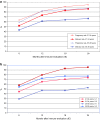Two-year outcome after recurrent first trimester miscarriages: prognostic value of the past obstetric history
- PMID: 26796678
- PMCID: PMC4829626
- DOI: 10.1007/s00404-015-4001-x
Two-year outcome after recurrent first trimester miscarriages: prognostic value of the past obstetric history
Abstract
Purpose: Recurrent miscarriage (RM) is a stressful condition which gives rise to extensive diagnostic evaluation and is seen as a potentially curable maternal disease. Nevertheless, epidemiological data have shown that outcome is related to fertility. In addition to maternal age and number of preceding miscarriages, further markers derived from the past history may support counselling.
Methods: Observational trial comprising 228 couples who were referred between 1996 and 2003 for immunological evaluation at maternal ages 20-39 years after three or more spontaneously conceived primary first trimester miscarriages. They were interviewed in 2005, ongoing pregnancies were followed up until birth in 2006. Past obstetric history was correlated with 2 year cumulative pregnancy and delivery rates (CPR, CDR).
Results: CPR and CDR were 206/228 (90.4 %) and 174/228 (76.4 %). Duration of infertility was associated with lower CPR (up to 3/>3 years, p < 0.01), whereas age and number of preceding losses inversely correlated with CDR (<35 years/35-39 years, p < 0.002; 3/>3 miscarriages, p < 0.002). Detection of an embryonic heart beat in 2-3 of the first three miscarriages resulted in favourable outcome (CPR: p < 0.02, CDR: p < 0.002). Prognosis was excellent in younger fertile women after three miscarriages where vital signs had been detected; under less favourable conditions not only risks for further miscarriage, but also for secondary infertility were elevated.
Conclusion: Secondary infertility is a feature of RM. Embryonic vital signs in preceding pregnancies are prognostic markers and should be regarded as a strong confounding factor in trials on therapeutic interventions. Prevention may be more appropriate than treatment.
Keywords: Cardiac activity; Embryo; Infertility; Karyotype; Pregnancy loss; Spontaneous abortion.
Figures


Comment in
-
Two-year outcome after recurrent first trimester miscarriages: prognostic value of the past obstetric history.Arch Gynecol Obstet. 2017 Jan;295(1):261-262. doi: 10.1007/s00404-016-4213-8. Epub 2016 Oct 15. Arch Gynecol Obstet. 2017. PMID: 27744502 No abstract available.
-
Answer to the editor.Arch Gynecol Obstet. 2017 Jan;295(1):259. doi: 10.1007/s00404-016-4210-y. Epub 2016 Oct 26. Arch Gynecol Obstet. 2017. PMID: 27785572 No abstract available.
Similar articles
-
Spontaneous first trimester miscarriage rates per woman among parous women with 1 or more pregnancies of 24 weeks or more.BMC Pregnancy Childbirth. 2017 Dec 22;17(1):437. doi: 10.1186/s12884-017-1620-1. BMC Pregnancy Childbirth. 2017. PMID: 29272996 Free PMC article.
-
Fertility after recurrent miscarriages: results of an observational cohort study.Arch Gynecol Obstet. 2018 Jan;297(1):205-219. doi: 10.1007/s00404-017-4532-4. Epub 2017 Oct 16. Arch Gynecol Obstet. 2018. PMID: 29038842 Free PMC article.
-
Non-visualized pregnancy losses are prognostically important for unexplained recurrent miscarriage.Hum Reprod. 2014 May;29(5):931-7. doi: 10.1093/humrep/deu042. Epub 2014 Mar 6. Hum Reprod. 2014. PMID: 24603132
-
A review of reproductive outcomes of women with two consecutive miscarriages and no living child.J Obstet Gynaecol. 2019 Aug;39(6):816-821. doi: 10.1080/01443615.2019.1576600. Epub 2019 Apr 22. J Obstet Gynaecol. 2019. PMID: 31006300 Review.
-
Progestogen for preventing miscarriage in women with recurrent miscarriage of unclear etiology.Cochrane Database Syst Rev. 2018 Oct 8;10(10):CD003511. doi: 10.1002/14651858.CD003511.pub4. Cochrane Database Syst Rev. 2018. Update in: Cochrane Database Syst Rev. 2019 Nov 20;2019(11). doi: 10.1002/14651858.CD003511.pub5. PMID: 30298541 Free PMC article. Updated.
Cited by
-
Development of the OPAL prediction model for prediction of live birth in couples with recurrent pregnancy loss: protocol for a prospective and retrospective cohort study in the Netherlands.BMJ Open. 2022 Sep 23;12(9):e062402. doi: 10.1136/bmjopen-2022-062402. BMJ Open. 2022. PMID: 36153018 Free PMC article.
-
Recurrent pregnancy loss: current perspectives.Int J Womens Health. 2017 May 17;9:331-345. doi: 10.2147/IJWH.S100817. eCollection 2017. Int J Womens Health. 2017. PMID: 28553146 Free PMC article. Review.
-
The association between miscarriage and fecundability: the Norwegian Mother, Father and Child Cohort Study.Hum Reprod. 2022 Jan 28;37(2):322-332. doi: 10.1093/humrep/deab252. Hum Reprod. 2022. PMID: 34792121 Free PMC article.
-
Recurrent pregnancy loss: diagnostic workup after two or three pregnancy losses? A systematic review of the literature and meta-analysis.Hum Reprod Update. 2020 Apr 15;26(3):356-367. doi: 10.1093/humupd/dmz048. Hum Reprod Update. 2020. PMID: 32103270 Free PMC article.
-
Endometrial thickness and early pregnancy complications after frozen-thawed embryo transfers.Front Endocrinol (Lausanne). 2023 Aug 21;14:1066922. doi: 10.3389/fendo.2023.1066922. eCollection 2023. Front Endocrinol (Lausanne). 2023. PMID: 37670886 Free PMC article.
References
-
- WHO WHO: recommended definitions, terminology and format for statistical tables related to the perinatal period and use of a new certificate for cause of perinatal deaths. Modifications recommended by FIGO as amended October 14, 1976. Acta Obstet Gynecol Scand. 1977;56:247–253. - PubMed
-
- Royal College of Obstetricians and Gynaecologists (RCOG) (2011) The investigation and treatment of couples with recurrent first-trimester and second-trimester miscarriage. Green-topGuidelineNo.17
-
- Evaluation and treatment of recurrent pregnancy loss: a committee opinion. Fertil Steril 2012; 98: 1103–1111 - PubMed
Publication types
MeSH terms
LinkOut - more resources
Full Text Sources
Other Literature Sources
Miscellaneous

